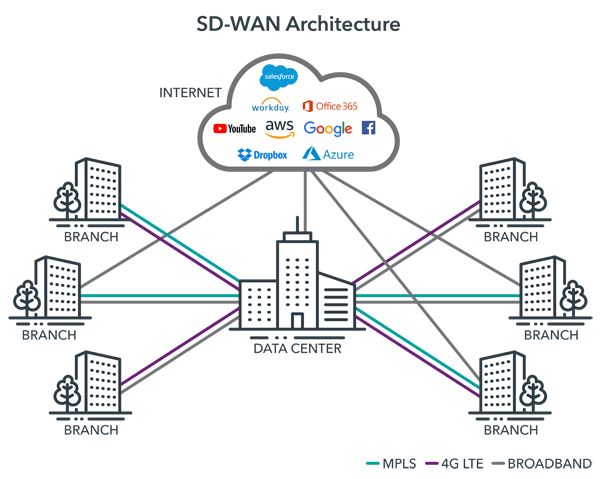In recent months, many companies have started explaining that they are using SD-WAN technologies to manage their networks. Many users are completely unaware of the existence of SD-WAN, what it is used for and what advantages it can offer to operators implementing it on their networks.
What is SD-WAN?
The first thing we need to know is what SD-WAN is. SD-WAN stands for Software-Defined Wide Area Network and is also known as Software-Defined Wide Area Network. It allows network operators to centrally manage and control all the hardware components through software in the simplest possible manner. It is invaluable for businesses that need reliable Internet and network connections.
One of the keys to SD-WAN is to allow companies to build their WAN on demand and pay for what they really need. You can read more from the FlexiWan Blog, which covers these topics in depth.
Advantages of SD-WAN
The main advantages of using SD-WAN, apart from improving the performance of applications, is that it improves bandwidth management, adapting it to the needs and priorities of the companies in a totally customized way. All this control and management is done from a single centralized platform, allowing any change to be applied almost immediately.
Another important advantages is superior security, since data is encrypted end-to-end and all communications are supervised by a fully manageable firewall. SD-WAN allows allows for Cost reduction for both the telecommunications providers and the end company, since the ISP needs less specific hardware to be able to offer the client its contractual needs and for the client this translates into a reduction in the cost to be paid monthly.
The speed of any change needed in terms of company communications is almost instantaneous, since everything is managed by software, and everything is controlled from a single place.
Security
Over the years, the evolution of telecommunications and the transfer of physical systems to the cloud has led companies to realize that current WAN systems are not designed for the cloud-based era. The increase in network traffic over the last decade has resulted in greater data management complexity and lack of application performance, along with data vulnerability.
This has been further exacerbated by the fact that more and more companies are relying on the Internet and the cloud for all their day-to-day operations. It has become extremely difficult to protect the different resources of a company due to the amount of different data and accesses that are needed at any level. Due to the possibility of being able to configure and distribute bandwidth over the WAN, and filter all data through the different VPNs used by SD-WAN, control and security is becoming easier for enterprises.
Across many systems used by companies, security is usually provided by a firewall or antivirus application managed from a central server responsible for managing all the traffic and controlling it from a single place. However, with the SD-WAN system, the data does not have to return to the central security server where it is located, since each place is secure without having to depend on a main server.
Advanced performance
The WAN architecture previously used on different sites and companies in the same group is limited in terms of functionalities or configurations. Due to more cloud application deployments, the WAN architecture has experienced an increase in traffic that has unfortunately resulted in a negative impact on the performance of applications or information transfer. In addition, due performance issues that can occur as a result of increased network traffic, the costs associated with WAN services have increased exponentially due to the lack of proper management of the bandwidth used.
The only technology that currently allows companies to manage all these problems is SD-WAN, since it enables bandwidth management efficiently and also offers better routing, protection against threats and simplification of WAN network administration.
But the advantages do not end there. In addition to the two advantages listed above, SD-WAN also offers the following advantages:
- It offers high availability with predictable SLA in all the applications used by the company. It can determine when more bandwidth is needed and for which application it is.
- It allows for dynamic routing of application traffic to adapt the necessary bandwidth to each application.
- It has integrated security without having to rely on a single server to manage all traffic and security, thus optimizing costs and network performance.
- It provides application recognition policies in real time to detect possible problems in the network and to be able to act before any problem occurs.
- All traffic is secure over the Internet due to the use of SD-WAN.
- Applications using the cloud are optimized for higher performance.
- You can perform any WAN extension smoothly, and have the changes applied in real time.
- A single centralized administration panel to perform all configuration and administration, so you can manage everything easily, quickly and efficiently.
The benefits of SD-WAN are numerous. It is a very versatile solution more network operators will adapt.





